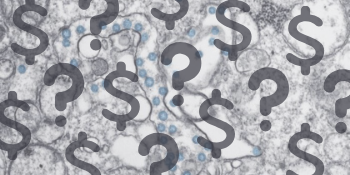By John Kirby, Investment Officer
 Markets are moving fast, and circumstances are changing on a daily basis. COVID-19, aka coronavirus, has brought global markets to an inflection point. At the time of this writing, the Federal Reserve has cut interest rates by 50 basis points in an unprecedented emergency move, “act[ing] as necessary to sustain the expansion.” So far, that move has failed to calm markets, and only time will tell if other central banks will follow suit.
Markets are moving fast, and circumstances are changing on a daily basis. COVID-19, aka coronavirus, has brought global markets to an inflection point. At the time of this writing, the Federal Reserve has cut interest rates by 50 basis points in an unprecedented emergency move, “act[ing] as necessary to sustain the expansion.” So far, that move has failed to calm markets, and only time will tell if other central banks will follow suit.
At the same time, equity markets have had multiple daily 1,000-point swings as traders come to terms. Bonds have been absolutely obliterated with the 10-year Treasury note falling below one percent for the first time in history. Recently, the Organization for Economic Cooperation and Development (OECD) predicted that global GDP growth would be halved in the first quarter of 2020 as a result of the virus impact. Could this be the end of the longest economic expansion in U.S. history?
Essentially, there are two broad potential outcomes at this point: 1) the virus is contained in the near term and markets return to “normal,” whatever that is nowadays, or 2) the virus goes uncontained and what follows is anybody’s guess, but it probably isn’t good.
What does this mean for credit unions?
Strategic Plans. It’s too early to tell… China’s containment efforts seem to be effective at this point, although some dispute the veracity of their reporting. Worldwide governmental responses have not been coherent, with some countries downplaying the risk and others implementing travel restrictions and quarantine protocols.
It seems certain there will be some negative macro-economic effects, but what those effects will be – as well as their magnitude – remains elusive. Until we know more, the best overall course of action for credit unions is to maintain their current strategic plan as set forth at the beginning of the year, with small potential adjustments based on changes in market conditions. If markets continue to snowball over the next couple of months, a change in strategy may be warranted.
Interest Rates. All-time lows across the yield curve have market experts, like Jan Loeys of JPMorgan Chase, speculating about the possibility of negative rates in the United States as soon as next year, potentially lumping us in with the current $14 trillion of outstanding sovereign debt with a negative yield.
For now, with full employment, historically low rates could be a mixed blessing for credit unions. If the United States maintains its low unemployment rate – which is part of the reason the Fed cut rates – historically low rates could mean a spike in loan demand as consumers seek to take advantage of what may end up being the cheapest borrowing rates in history.
Higher loan demand with lower rates creates a unique situation, but hopefully, credit unions will be able to maintain strong net spread margins with a corresponding lower cost of funds. Although historically low deposit rates could send members – savers or investors – looking for every basis point of yield they can find, it could potentially lead to a shortage in deposits to match loan demand. That could ultimately result in another liquidity crunch, as seen in recent years. Hopefully, at least borrowing will be cheap.
Investment Portfolio. Above all else, the lesson learned from the Great Recession is that sitting on cash and waiting for a rebound in rates is not a strategy. Cash rates dropped 50 basis points after the Fed’s emergency cut. If further cuts occur, cash rates will continue to fall, and many will wish they’d locked in current rates for longer terms. Also, as an alternative to borrowing or CD issuance to meet funding demands, highly loaned out credit unions might consider liquidating securities. The recent rate decline means a lot of portfolios could be sitting on potential profits as premiums rise. Therefore, it is better to free up cash with a profit than to pay interest.
At this point, the broad takeaway is that no one, not even the markets, or the Fed, knows what comes next. At an inflection point like this, we “err on the side of caution.” If the virus is contained, this whole sequence of events will end up being a blip in market history. If not, there’s no telling what’s ahead.
All securities are offered through CU Investment Solutions, LLC. The home office is located at 8500 W 110th St, Suite 650, Overland Park, KS 66210. CU Investment Solutions, LLC registered with the Securities and Exchange Commission (SEC) as a broker-dealer under the Securities Exchange Act of 1934. CU Investment Solutions, LLC is registered in the state of Kansas as an investment advisor. Member of FINRA and SIPC. All investments carry risk; please speak with your representative to gain a full understanding of said risks. Securities offered are not insured by the FDIC or NCUSIF and may lose value. All opinions, prices and yields are subject to change without notice.